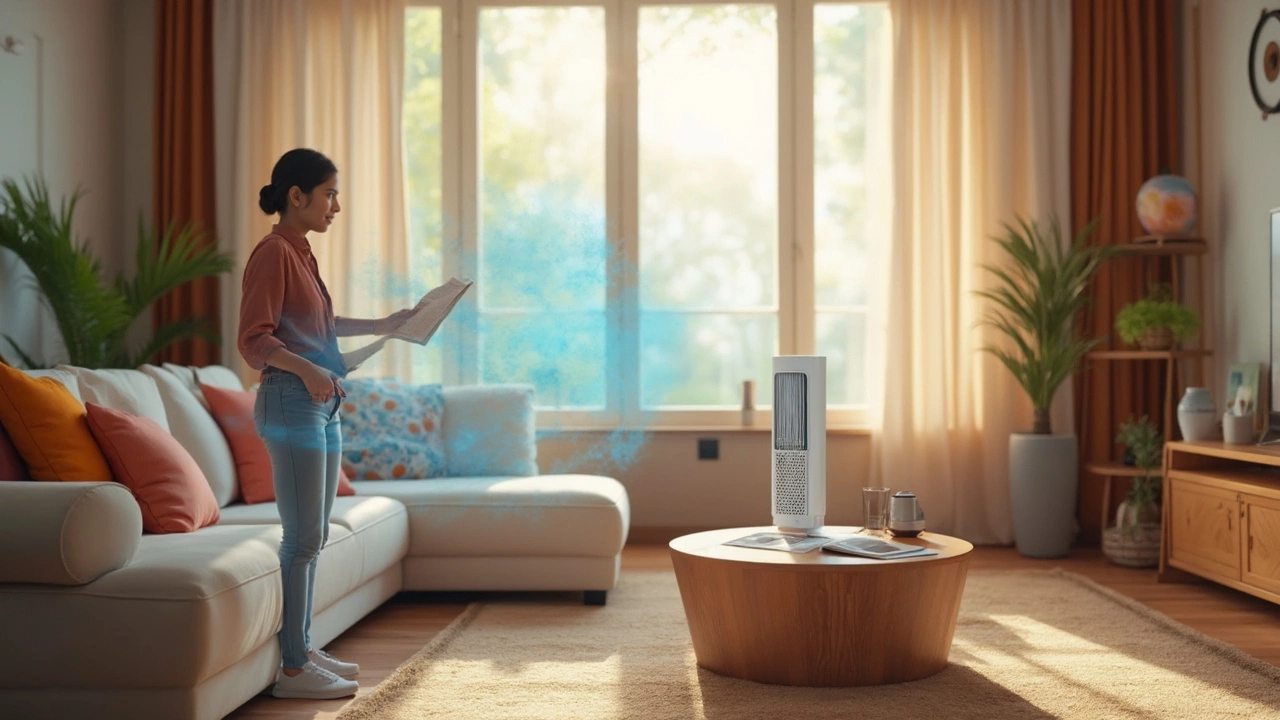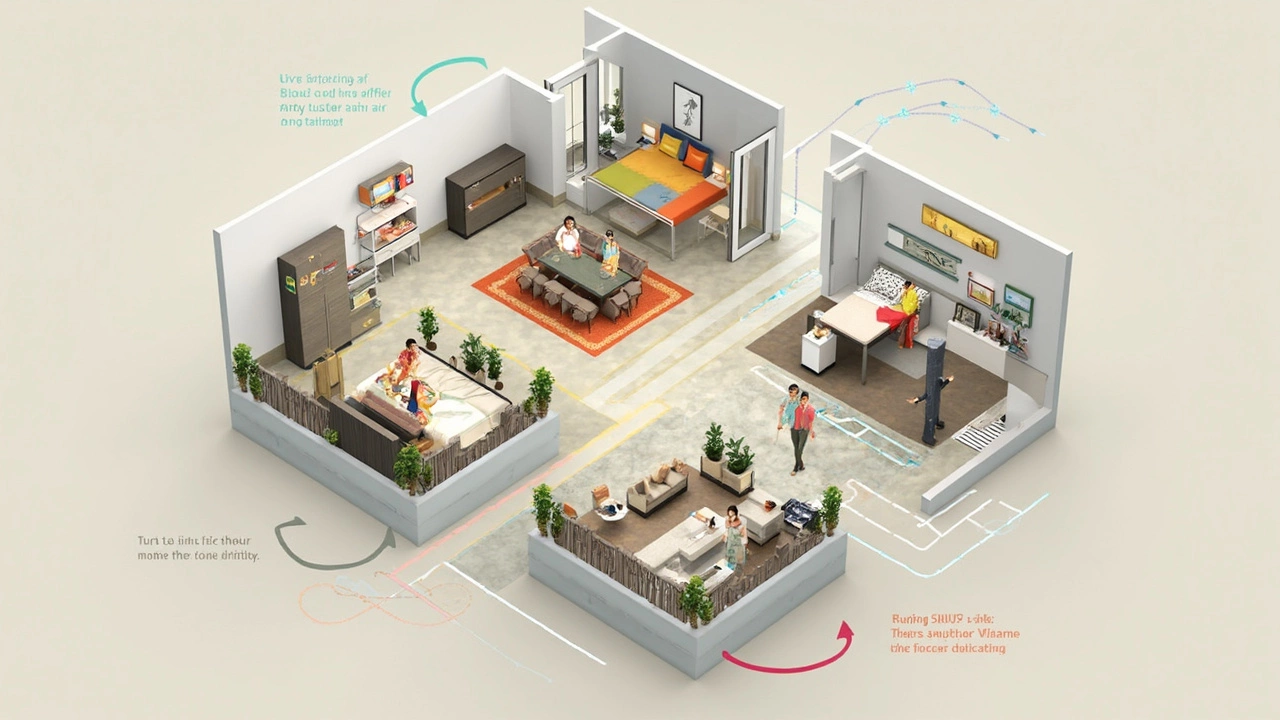
If you just plugged in your new air purifier and stuck it in a corner, you’re not alone. Most folks think any spot will do, but picking the right place matters—a lot. The purifier needs space to do its job and, believe it or not, a bad spot can cut its power by half or more.
Here’s the deal: air purifiers pull in dirty air, trap the junk, and then blow out cleaner air. If you shove it behind furniture or right up against a wall, the airflow gets blocked. That means you’re missing out on cleaner air and your machine is working harder than it needs to.
So, what’s the secret? Pick a spot where the air really moves. That’s usually somewhere near the center of the room or at least a few feet away from anything big—the couch, bed, or bookshelf. You want the “inhale” and “exhale” sides of the purifier to have a little breathing room (pun intended).
It sounds simple, but this small change can mean the difference between just a fresher-smelling room and actually breathing cleaner air. Ready to pick the perfect spot? Stick around for easy tips that’ll help you get the most out of that new gadget.
- Why Placement Matters More Than You Think
- Common Placement Mistakes (And What to Do Instead)
- Room-by-Room Tips for Maximum Air Cleaning
- Little-Known Tricks to Boost Your Air Purifier’s Performance
Why Placement Matters More Than You Think
You might think all air purifiers work the same, no matter where you put them. Not true. Tests from big names like Consumer Reports and Wirecutter show that where you put an air purifier can affect how much dust and allergens get caught—sometimes by 50% or more. Airflow is everything. If the purifier can't suck in dirty air and push out clean air properly, you're just wasting electricity.
It turns out, the air in your room doesn’t move in a straight line. Warm air rises, cool air drops, and doors opening and closing can send particles all over the place. That's why shoving your machine into a dead spot (like behind curtains or tucked in a corner) just doesn't cut it. A study from the University of Texas found purifiers perform best when they’re away from large objects and at least 6–12 inches from the nearest wall.
If you want results, look at this real-world example:
| Purifier Placement | Particle Removal Rate in 1 Hour |
|---|---|
| Against wall, blocked by furniture | 27% |
| Open area, 10 inches from wall | 68% |
| Right under window (drafty) | 51% |
That’s a huge swing just by moving your purifier. You might be thinking, “What’s the best spot?” Look for somewhere with open space, away from anything that might block airflow. Don’t put it right under a vent or heat source—the temperature difference messes with how the air moves. The goal is to give the air purifier placement top priority, not just plug it in wherever there’s an outlet.
If you’ve got allergies, pets, or just want to cut down on dust, small tweaks to where you set up your unit can make a big difference fast. It’s not just marketing talk—studies and real stats back it up. Next time you set up your purifier, treat it like setting the foundation for your whole indoor air setup.
Common Placement Mistakes (And What to Do Instead)
It’s wild how often people make the same blunders with their air purifier placement, but it’s usually not their fault. The instructions that come in the box? Usually useless on this front. Let’s clear up the confusion by looking at mistakes that trip up even the savviest folks—and how to fix them fast.
- Hiding in the Corner: Shoving your unit in a corner or behind your TV sounds like it’ll keep things tidy, but it’s a big no. Purifiers need open space to pull air from all over the room. When they're boxed in, you’re only cleaning the stale air from that cramped side area, not the stuff you’re breathing around the room.
- Too Close to the Wall: Most air purifier placement guides say to leave at least 18 inches (about 45 cm) between the purifier and any wall or large furniture. Anything closer kills proper airflow—think of trying to suck a thick milkshake through a tiny straw.
- Obstacles in the Way: Don’t put your purifier behind a sofa, under a desk, or crammed next to piles of laundry. Obstructions mean it won’t 'inhale' enough air, and the filtered air won’t reach the spots you need it most.
Placement isn’t about keeping it pretty—it’s about making it work. Here’s a quick breakdown of what to avoid and what to do instead:
| Mistake | Why It's Bad | What Works Better |
|---|---|---|
| Next to walls/corners | Blocks airflow, cleans only nearby air | Stick it at least 1–2 feet from walls and objects |
| Near electronics or appliances | Heat and electrical noise can throw off sensors | Place away from TVs, microwaves, heaters |
| Under shelves or low tables | Limits vertical air movement | Keep on open floors or on a small stand |
| Direct sun or vents | May mess with sensors or overheat | Keep away from direct sunlight or air vents |
One more tip—a lot of models have an air quality sensor. If that’s blocked or buried, the purifier can’t measure the real air in your room. And don’t forget electrical safety: make sure cords don’t get pinched or sit under heavy furniture.
Getting these little things right doesn’t just power up your air purifier’s performance, but also helps the filter and fan last longer, saving you money and hassle over time.

Room-by-Room Tips for Maximum Air Cleaning
Not all rooms are built the same. What works in your bedroom might flop in a big living room or a steamy kitchen. Let’s break it down with real info and simple actions tailored for each spot in your house.
Living Room: This is usually the hub where people hang out, so you want your air purifier front and center—literally. Stick it a couple of feet from walls or big couches. Don’t hide it behind the TV or a plant. If your living room’s large or has an open plan, you might need a purifier with extra muscle (check the CADR rating for big spaces—it should match your room’s square footage). Pro tip: Put the unit near the usual airflow, like close to a vent or doorway, since that’s where particles like dust and pet hair float in.
Bedroom: Nighttime is when your body heals, so fresh air matters most here. Put the purifier close to where you breathe—usually near your bed but not right against your pillow. Point the "clean" side towards you, with at least 18 inches from walls. Running it on low at night works for most modern purifiers (they’re pretty quiet now), so don’t stress about noise. Bonus: Allergy or asthma sufferers usually see big benefits after just a week when using the right placement.
Kitchen: Cooking kicks up smoke and grease. Set your air purifier away from direct heat or moisture (like right next to the stove or sink). It’s best along an open countertop or on a small table near the middle of the kitchen. For quick odor removal after frying, set your purifier to high for 30 minutes. Many modern models catch greasy particles and VOCs, but check your filter type to be sure.
Home Office: Electronics, printers, and paper can pump out extra dust and particles. Place your purifier near your desk but not tucked under it. Try to keep it away from piles of paper or electronics that block air flow. If you snack at your desk (guilty!), keep the purifier nearby to zap leftover food smells faster.
To make your life easier, here’s a quick look at best spots by room:
| Room | Best Placement | Why |
|---|---|---|
| Living Room | Mid-room, near airflow, away from walls/furniture | Captures particles from entering traffic areas |
| Bedroom | Near bed, 18+ inches from walls | Clean air where you breathe while sleeping |
| Kitchen | Mid-counter, away from stove/sink | Targets odors and cooking particles |
| Home Office | Next to desk, not under or behind | Keeps air clean from electronics and food smells |
Be sure to move your air purifier placement if you notice dust or smells hanging around—sometimes a quick shuffle makes a huge difference. Always keep an eye on the filters, too. A dirty one will slow down even the fanciest machine. Small shifts and a little attention will get you the best out of every room—no matter the season.
Little-Known Tricks to Boost Your Air Purifier’s Performance
It’s easy to just turn on your purifier and forget it’s even there. But there are some simple tweaks that can upgrade how well it works—some of these will surprise you.
First up: pay attention to your doors and windows. If you leave a window cracked, that purifier’s working overtime and probably losing the fight against outdoor air sneaking in. For best results, keep the room as sealed as possible.
Did you know your purifier’s filter gets clogged way faster in high-traffic areas? People walking by, pets running around—it all stirs up more dust. Check your filter once a month instead of just relying on those “change filter” lights. If you have pets or allergies, every two or three weeks could make a real difference in air quality.
Placement matters, but so does how often you run it. Running the purifier at the lowest setting 24/7 usually beats short bursts on high. There’s a stat from Smart Air Labs showing that running a purifier non-stop at even half speed reduces particle levels by 40% more than running it at full blast for just a couple hours a day.
Here’s another trick: if you’ve got a ceiling fan or box fan in the room, use it. Fans help move air around, which means your air purifier placement is even more effective. Just make sure the purifier isn’t blowing the dirty air right back across the room.
If you want to geek out on numbers, check this quick comparison:
| Trick | Approx. Clean Air Improvement |
|---|---|
| Seal doors & windows | +15% clean air |
| Change filters ahead of schedule | +10-20% efficiency |
| Run continuously (low speed) | +40% fewer particles |
| Add a room fan | +10% improved circulation |
One more thing: don’t forget about “filter aging.” Even if a filter looks clean, it could be losing its ability to trap ultra-fine particles after six to twelve months. Always check the model’s guidance and jot down the install date somewhere handy. As Dr. Richard Shaughnessy, director of the Indoor Air Research Program at the University of Tulsa, puts it:
"A filter that's past its prime won't capture what it used to. Swapping it out can make the same purifier perform like new again."
All these tweaks might sound nitpicky, but stack them together and you’re suddenly breathing a whole lot easier. That’s what smart air purifier use is really about.